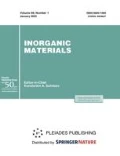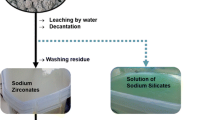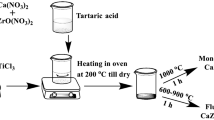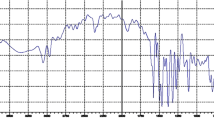Abstract
The influence of the synthesis conditions, the nature of the added component, and its concentration on the formation of fine-particle M-Zr-O (M = Fe, Y, La) materials was studied in the temperature range 383-973 K. The materials prepared at a variable pH of precipitation and containing 2-33 mol % M2O3 were x-ray amorphous in the range 383-673 K, except for the Fe-Zr-O samples with 33 mol % Fe2O3, which contained α-Fe2O3. Heat treatment at 973 K resulted in the formation of ac-ZrO2-based solid solution, whose lattice parameter depended on the nature and concentration of the second component. The minimum particle size of the materials studied was 2.5–12 nm in the range 383–673 K and 3–47 nm at 973 K.
Similar content being viewed by others
References
Ivanova, A.S., High-Temperature Fine-Particle Supports and Catalysts in MnOm-Al2O3 (M = Mg, Y, La, Si, Zr, Ce) Systems,Zh. Prikl. Khim. (S.-Peterburg), 1996, vol. 69, no. 11, pp. 1790–1800.
Ivanova, A.S., Moroz, E.M., and Litvak, G.S., Physicochemical Properties of Coprecipitated La-Zr-O and Ce-Zr-O Materials,Kinet. Katal., 1992, vol. 33, no. 5/6, pp. 1208–1214.
Viktorov, V.V. and Fotiev, A.A., Phase Relations in ZrO2-Cr2O3-Y2O3Mixtures Obtained by Thermolysis of Hydroxides,Neorg. Mater., 1993, vol. 29, no. 9, pp. 1254–1256 [Inorg. Mater. (Engl. Transl.), vol. 29, no. 9, pp. 1112-1114].
Wu, J.-C., Liu, D.-S., and Ko, A.-N., Dehydrogenation of Ethylbenzene over TiO2-FeO3 and ZrO2-Fe2O3 Mixed Oxide Catalysts,Catal. Lett., 1993, vol. 20, no. 3/4, pp. 191–201.
Guglieminotti, E. and Boccuzzi, F., A New Catalyst for the Removal of the NOx Emissions: Fe/ZrO2,Environ. Catal. Better World and Life: Proc. I World Congr., Rome, 1995, pp. 295–298.
Xiang, H., Zhong, B., Peng, S.,et al., Preparation, Characterization, and Fischer-Tropsch Catalytic Behavior of an Ultrafine-Particle Fe/ZrO2 Catalyst,Fenxi Huaxue, 1995, vol. 9, no. 1, pp. 13–22.
Price, W. J.,Analytical Atomic-Absorption Spectroscopy, New York, 1976.
Alekseevskii, E.V., Gol’ts, R.K., and Musakin, A.P.,Kolichestvennyi analiz (Quantitative Analysis), Leningrad: Goskhimizdat, 1955, p. 322.
Physical and Chemical Aspects of Adsorbents and Catalysts, Linsen, B.G., Ed., London: Academic, 1970. Translated under the titleStroenie i svoistva adsorbentov i katalizatorov, Moscow: Mir, 1973, pp. 335–337.
Umanskii, Ya.S.,Rentgenografia metallov (X-ray Diffraction Analysis of Metals), Moscow: Metallurgiya, 1960, p. 273.
Buyanova, N.E., Karnaukhov, A.P., and Alabuzhev, Yu.A.,Opredelenie poverkhnosti dispersnykh i poristykh materialov (Specific Surface Measurements for Fine-Particle and Porous Materials), Novosibirsk: Inst. Kataliza, Sib. Otd., Akad. Nauk SSSR, 1978.
Fedotov, M.A., Krivoruchko, O.P., Golovin, A.V., and Buyanov, R.A., Hydrolytic Polymerization of Aquo Ions of Metals in Mixed Aqueous Solutions ofFe(III)-Al(III) Salts,Izv. Akad. Nauk SSSR, Ser. Khim., 1977, no. 2, pp. 473–475.
Krivoruchko, O.P., Buyanov, R.A., Fedotov, M.A., and Plyasova, L.M., On the Mechanism of Bayerite Formation in Pseudoboehmite,Zh. Neorg. Khim., 1978, vol. 27, no. 7, pp. 1798–1803.
Fedotov, M.A., Taraban, E.A., and Buyanov, R.A., NMR Study of Hydrolytic Polycondensation of Aquo Ions in Al(III)-Cr(III) Nitrate Solutions,Zh. Neorg. Khim., 1993, vol. 38, no. 11, pp. 1849–1854.
Lukachina, E.N., Stetsenko, V.I., and Ermolenko, I.V., Mechanism of Y3Fe5O12 Formation in the Y(OH)3-Fe(OH)2 System,Izv. Akad. Nauk SSSR, Neorg. Mater., 1978, vol. 14, no. 1, pp. 102–105.
Khimiya redkikh i rasseyannykh elementov (Chemistry of Rare and Less-Common Elements), Bol’shakov, K.A., Ed., Moscow: Vysshaya Shkola, 1965, vol. 1, p. 138.
Polezhaev, Yu.M., Barbina, T.M., and Polezhaev, V.Yu., Thermal Behavior of Coprecipitated Metal Zirconium Hydroxides (M = Sc, Y, Ln),Neorg. Mater., 1994, vol. 30, no. 7, pp. 959–962 [Inorg. Mater. (Engl. Transl.), vol. 30, no. 7, pp. 889–891].
Strekalovskii, V.N., Polezhaev, Yu.M., and Pal’guev, S.F.,Oksidy s primesnoi razuporyadochennost’yu (Oxides with Impurity Disordering), Moscow: Nauka, 1987.
Ivanova, A.S., Bobrova, I.I., Moroz, E.M.,et al., Ni-Y-Zr-O Catalysts for Methane Steam Conversion: Preparation and Catalytic Activity,Kinet. Katal., 1997, vol. 38, no. l,pp. 114–118.
Dzis’ko, V.A., Karnaukhov, A.P., and Tarasova, D.V.,Fiziko-khimicheskie osnovy sinteza oksidnykh katalizatorov (Physicochemical Principles of the Synthesis of Oxide Catalysts), Novosibirsk: Nauka, 1978.
Author information
Authors and Affiliations
Rights and permissions
About this article
Cite this article
Ivanova, A.S., Fedotov, M.A., Litvak, G.S. et al. Preparation of fine- particle zirconia- based materials. Inorg Mater 36, 352–358 (2000). https://doi.org/10.1007/BF02758081
Received:
Issue Date:
DOI: https://doi.org/10.1007/BF02758081




